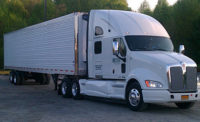Safe food transport is a critical issue for freight companies. It is also important to brokers who arrange transport. Although a freight broker surety bond provides protection when there are claims, a broker must ensure that a freight company follows best practices. If you are responsible for safe food transport, you must ensure that steps are taken to protect loads from spoilage, contamination and damage. These are some ways freight companies deal with food transportation risks today.
1. Improved Cleaning Procedures and Accountability
With all the recalls in recent years due to contamination, it is critical to reduce risks at every point. Although contamination can happen in production facilities, some foods can be contaminated during transportation if cleaning procedures for trailers are inadequate. Loaders and shippers can ask freight carriers about the cleaning processes of trailers. Because of this, it is important for freight companies to implement strict cleaning and sanitizing procedures.
Although the Food and Drug Administration's (FDA) Sanitary Transportation of Human and Animal Food rule does not outline specific recommendations on how to clean trailers, freight companies must be proactive in developing a strategy that includes cleaning, sanitizing – and especially – good recordkeeping. Even with good cleaning and sanitizing practices, poor recordkeeping can leave shippers and loaders questioning a freight company's competence. There should be a good system for accountability in completing tasks, verifying completion, recording data, and safely storing the information.
2. Detailed Inspection of Cargo Space
This step is important after a thorough cleaning. Freight companies must inspect trailers prior to loading to ensure there are no cross-contamination risks. Experts recommend equipping employees who inspect trailers with the proper tools. These tools include a scraper or spatula, camera or recording device, calibrated thermometer, and flashlight. The flashlight should be between 15,000 and 20,000 lumens. Trailers should be free of hazards that could lead to contamination, spoilage, or damage to food.
3. Thorough Temperature Control Monitoring
When shipping temperature-controlled items, the trailer should be pre-cooled for better results. Prior to loading temperature-controlled goods, the unit's set point should be examined. An employee should also check and record the temperature of the unit at the time of loading. Some companies also use a device that continually records temperature.
Once the load is transported to the destination, the temperature of the items should be evaluated before unloading. A driver should take and record the air temperature around the items. When a vehicle is fully loaded, there should be a minimum of three temperatures taken from products in different areas of the load. These should be at the front, middle, and back of the trailer.
To minimize risks, a freight company should also instruct drivers to document receiving inspections and data from personnel at the destination facility. Documentation should include temperature verification, the condition of the products and any other important comments. For example, rejected items, damage, or other findings must be reported. Qualified personnel at the receiving facility should sign the form.
4. Better Food Safety Training and Ongoing Training
One of the key food safety risks identified by the FDA in transportation is improper training of drivers. They must have a thorough understanding of the loads they are hauling and how to keep them safe in transit. Training must satisfy the FDA's minimum requirements, and the agency offers a free online training module for those who transport food.
Freight companies can also reduce risks with additional training or ongoing training. It helps to refresh drivers' knowledge and to provide them with any updated changes or information if it becomes available. However, it is not only drivers who benefit from ongoing training. All employees of the freight company can benefit. For example, if there are employees who clean the trailers and handle documentation, ensuring they receive proper initial training and ongoing training can be beneficial in reducing food safety risks.
5. Stronger Preventive Maintenance and Pest Control Plans
Even if a trailer is clean and maintains the proper temperature, there are still other problems that can lead to food spoilage or contamination. Pests and improper maintenance are two common culprits of such problems. In the FDA report referenced earlier on common contributors to food safety risks in transportation, both these problems were on the list. It is important for freight companies to ensure that all trucks adhere to strict maintenance plans. Mechanical breakdowns from improper maintenance can lead to delays in shipping and unnecessary expenses.
In addition to tire inspections, oil changes, and other mechanical maintenance, trailer features must be maintained. This is especially important for transporting refrigerated or frozen items. Refrigeration units must be inspected and maintained to ensure they continue functioning properly. Even if the truck itself does not break down, the refrigeration system may lose temperature or break if there are issues. When there is temperature loss, the food may spoil or reach an unsafe temperature before it reaches its destination.
There are several types of pests that can cause costly problems. Bugs can get into flour, pasta boxes, or dry goods. Mice and rats are attracted to packaged and fresh foods. Although some pests may only be disgusting nuisances, others can cause harm. For example, rat urine can cause illnesses. By implementing and maintaining a thorough pest control strategy that addresses all potential pest risks, freight companies can reduce the risk of contaminated or infested loads.
6. Ensuring Correct Packing and Loading Steps
Improper packing and improper loading were also two problems the FDA listed in its report on food safety risks in transportation. Because improper loading and packing often result from employees with inadequate training, this point closely relates to the point about proper training of employees. Training must go beyond basic food safety relating to contamination and foodborne illnesses. For instance, employees must know which types of packing materials to use, how to tell if a pallet is safe for use, and other important information that relates to protecting food in transit. This can help reduce the risk of produce or other food packages being damaged in transit.
The United States Department of Agriculture (USDA) also recommends several food safety guidelines for loading temperature-controlled items. For example, foods that must be in a refrigerated area should not be left on a loading dock when the outdoor temperature is warm. During hotter periods, unloading and loading should be done in the morning or evening whenever possible.
Freight should be the correct temperature before loading it into a pre-cooled truck. If loads have different temperature requirements, freight companies must be careful to use good load staging practices. Also, prompt loading and unloading can help reduce the risk of spoilage. When interim storage is used, companies must implement additional temperature checks and ensure thorough recordkeeping.
Improper food transportation procedures can lead to a tarnished reputation, financial losses, and more. With these best practices in mind, it is easier for you to develop a strategy to ensure that spoilage, contamination, and damage risks are reduced.




